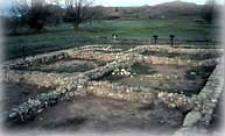Lake Scott Archaeology
category : Archaeology
 During the Pleistocene epoch, when glaciers came as far west as Lawrence, Kansas, dinosaurs lived in the area now named Lake Scott State Park. Once covered by an inland sea, this area has been the site of many fossil finds dating from 45 million to 140 million years ago.
During the Pleistocene epoch, when glaciers came as far west as Lawrence, Kansas, dinosaurs lived in the area now named Lake Scott State Park. Once covered by an inland sea, this area has been the site of many fossil finds dating from 45 million to 140 million years ago. History is preserved through land formations, and fossil relics which the land releases to our careful excavations and buildings on the land which were built by our pioneering forefathers. 70-80 million years ago there was an inland sea from the present Gulf of Mexico to Alaska. Extinct fossil fish, swimming reptiles, even birds with teeth inhabited the area at that time. Then, later in the Tertiary period, when the Rocky Mountains were being formed our own beautiful Lake Scott State Park bluffs came into existence. When the Ice Age (right after the Tertiary period) produced glaciers as far west as Lawrence, Kansas, Scott County and the surrounding plains were pasture for rhinoceros, camels, mammoths, bison and horses. Giant land tortoises were in abundance. The Ice Age produced spectacular land formations such as Monument Rocks in Western Gove County. Natural springs at Lake Scott State Park provided water for animals and people alike. These abundant springs are the source of water for Lake Scott today.
The El Cuartelejo Indian Pueblo Ruins, nearly two centuries old, achieved National Historical Landmark Status in 1964. In 1970, the Kansas Historical Society carried out an extensive program of excavation and restoration of the area. The present site allows the visitor to see the pueblo site with its foundation reconstructed.
The 1888 Herbert Steele Homestead has been preserved much as it was over a hundred years ago and serves as a museum displaying the furnishings and tools used by the early settlers.
Just southeast of Lake Scott State Park is a picturesque canyon: the site of the last U.S. battle against the Indians in Kansas. Called the Battle of Punished Woman's Fork, it took place in the fall of 1878. A monument has been erected over Squaw's Den where Indian women and children hid in a cave while warriors waited in ambush for the cavalry.
Admission: Park Permit Required
Address: 12 miles north of Scott City on Highway K-95
Phone: 620-872-2061
Our Email: ScottSP@wp.state.ks.us
Come visit us in , Kansas